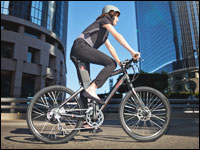
There is no denying that serious cyclists adopt some very specificforms of fashion. The jerseys and shorts are tight-fitting to reducedrag, gloves are worn both to provide padding while gripping thehandlebars and to protect hands during a crash, and shoes are afashion statement all of their own. But one piece of equipment hasbecome somewhat ubiquitous among casual and hardcore riders alike these days– the bicycle helmet.
The truth is that many still opt not to wear helmets for aplethora of reasons — from daily bicycle commuters who worry that itcould mess up their hair, to old school racers convinced they “know how to fall.” However,despite such reluctance, it’s clear that a helmet — or “brain bucket,” as cyclists tend tothink of it — does offer protection, especially in a serious crash.
Yet much of the development in the past decade has been to makehelmets more stylish, more breathable and more comfortable. These factors no doubt will encourage riders to wear a helmet — but safetyimprovements remain slow in coming.
“We’re seeing things like helmetsthat have larger vents, which makes them cooler, but that doesn’treally matter for safety,” said Randy Swart, director of theBicycle Helmet Safety Institute.
Technology Add-Ons
The materials used in helmets are essentially the same: a polystyrene foam body with a plastic outershell. This material typically provides a reasonable amount ofprotection should a bicycle rider fall or crash.
A few companies have added lights to helmets to help alert drivers atnight, but one problem is that add-ons can interfere with how a helmet is designed to protect a rider. Thebiggest culprit is actually the wearable action camera that ridershave increasingly been mounting to helmets. This provides a bluntobject that can damage the helmet and even cause an increased chanceof neck injury.
“Anything that goes on the outside of the helmet should flip offimmediately,” said Swart. “Many of the action cameras that mount tothe helmets are held on with Velcro, and these don’t tend to getknocked off so easily. The outside of the helmet needs to be round tohelp deflect some energy.”
However, not all the add-on products are so intrusive, and one newtechnology that is being shown at this week’s Interbike trade show inLas Vegas could actually work in conjunction with a helmet to save arider’s life following a catastrophic crash.
The ICEdot sensor doesn’tfundamentally change a helmet’s shape or protection characteristics. What itdoes do is call for help should the wearer be unable to do so.
“It’s a small device that will attach to the helmet,” said ICEdot CEO,Chris Zenthoefer. “It won’t alter the helmet’s structure or fit in anyway.”
Call for Help
The ICEdot sensor can work with a bicycle rider’s smartphone, where anapp can detect motion, changes in forces and notably impacts. In thecase of a traumatic crash, it can call for help and even send GPScoordinates. As many cyclists are now using smartphones as cyclingcomputers to track speed, distance, heart rate and calories, this takesit a step further as a “Life-Line” type of product.
In this way it could also encourage riders to bring a phone. Whilesome riders may want to “get away from everything,” the ability tocall for help shouldn’t one of them, noted Zenthoefer.
The ICEdot also could encourage riders to wear a helmet, butZenthoefer is less convinced of that and pointed out that thesensor and app do not serve as a reactive device for a crash.
“I think it is proactive,” Zenthoefer told TechNewsWorld. “A helmetcan only go so far to protect your head but often it’s not just the[straight-line] impact, but the angle of rotation that is more dangerous when you fall … . We’re measuring both and helping peoplebe more aware of what has happened to them in a crash and getting helpto them in case it is needed. We’re taking the idea of the helmet onestep further — protection plus a call for help.”
Because this is a device that attaches to a helmet, it could havepotential for many other fitness activities.
“We’re going after bikes first because that’s what we do and know,”said Zenthoefer. “However, it makes a lot of sense for snow sports,rock climbing, kayaking, motorcycles — anyone that wears a helmet.”
Wind in the Hair
The ICEdot isn’t the only technology that can respond and react to acrash. Hvding has created what itbills “the Invisible Helmet.” While it may be more apt to call it “the inflatable helmet,” it works by being there only when a rider actuallyneeds it.

When it’s not deployed, the fashion-centric “helmet” is actually wornaround the neck as a collar. Obviously this isn’t aimed at seriousmountain bikers or road cyclists but at commuters who want thewind in their hair rather than a brain bucket on their head.
“Our aim has always been to develop a helmet that would be soattractive that more cyclists would start protecting their heads intraffic,” said Terese Alstin, founder of Hvding.
“The project startedout with an extensive research with the purpose to understand why sofew people wear bicycle helmets. When we asked people what they’d ideally like the bicycle helmet oftomorrow to look like, they wished for something discrete that couldmatch their different outfits, something that wouldn’t ruin the hair –and one person even said he wished for an invisible bicycle helmet,”Alstin told TechNewsWorld.
“Hvding is the result of all the feedbackfrom our research,” she continued. “We took into consideration even the mostchallenging requests from the cyclists, which is why I’m convincedthat this product will encourage people who normally wouldn’t wear ahelmet to start protecting their heads on the roads.”
The helmet works by reacting to the motion of a rider and inflateswhen it detects sudden movement that is registered as a fall or crash.But is that enough?
“What happens when you hit a tree limb or hit a bus mirror with yourforehead?” asked Swart. “It is great new technology, and I like theidea that someone is working on the problem — but there are a millionquestions with this one and no answers.”





















































